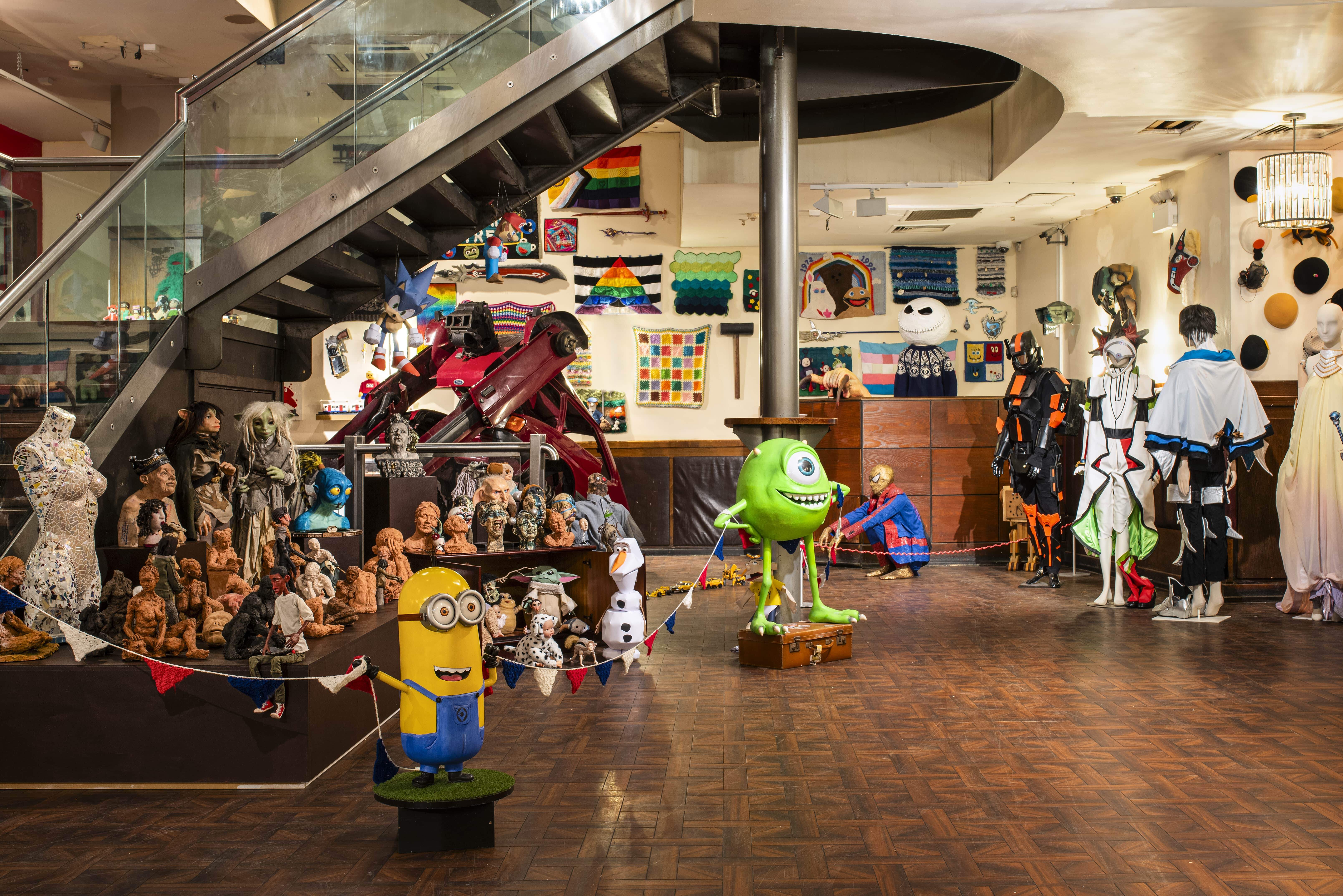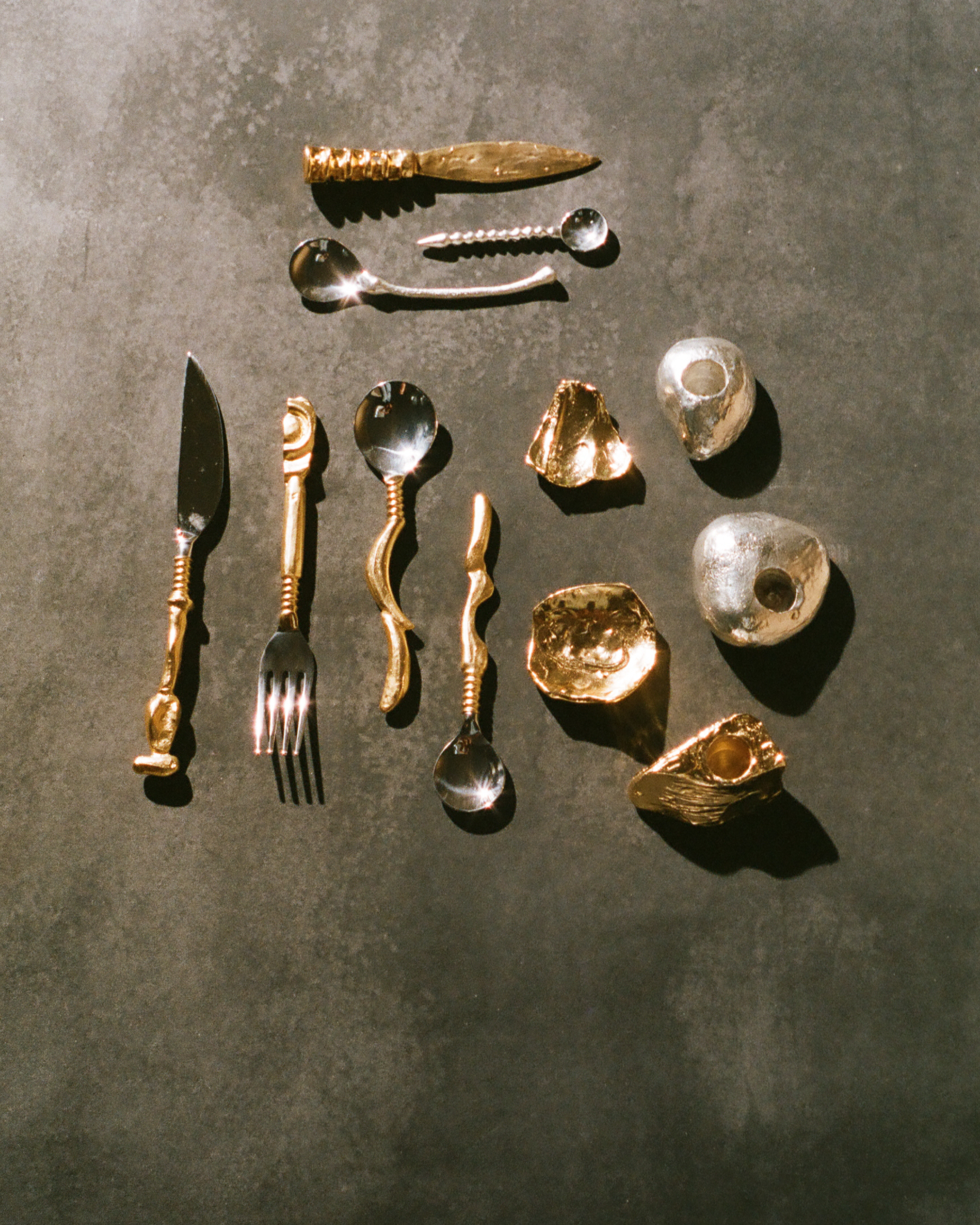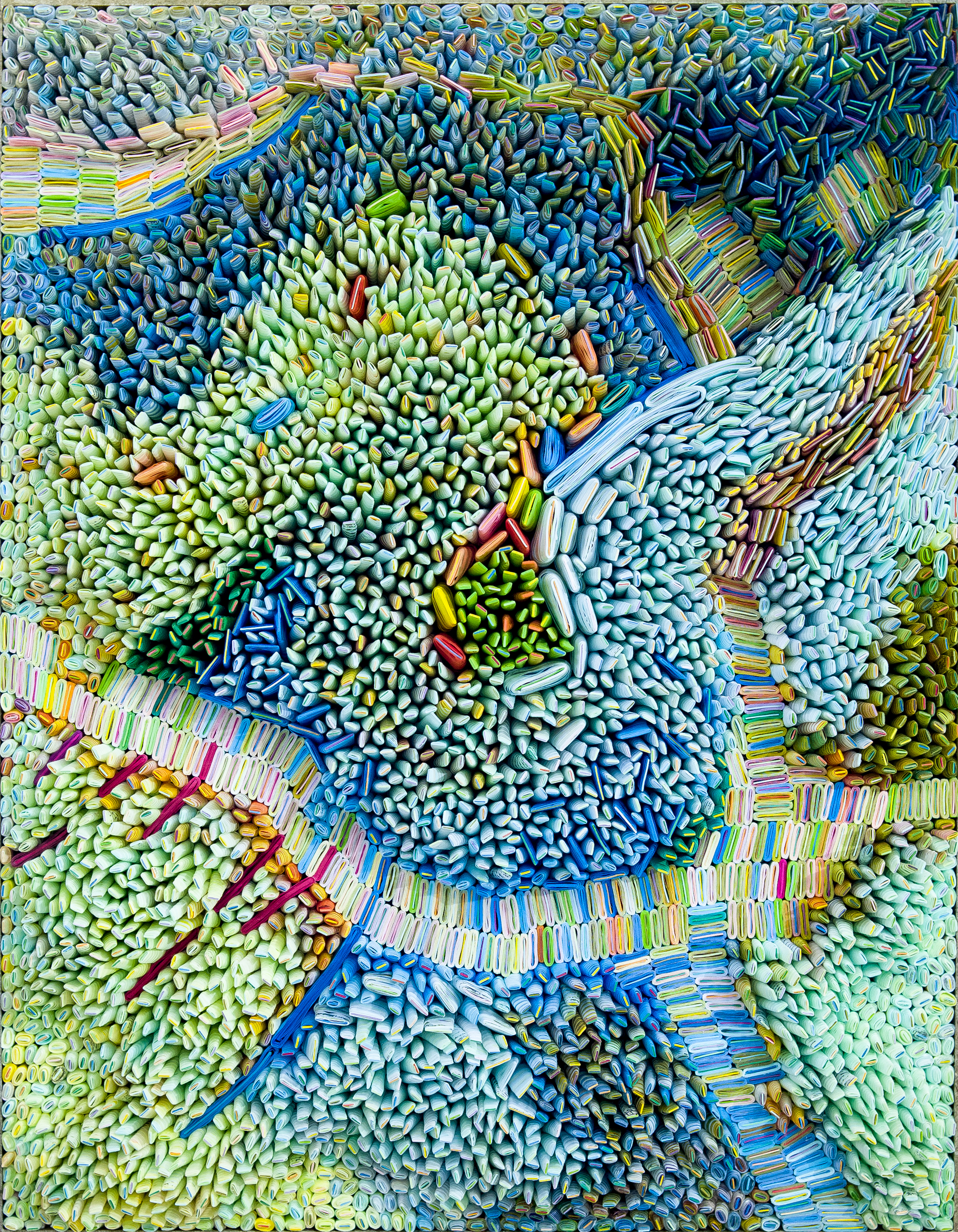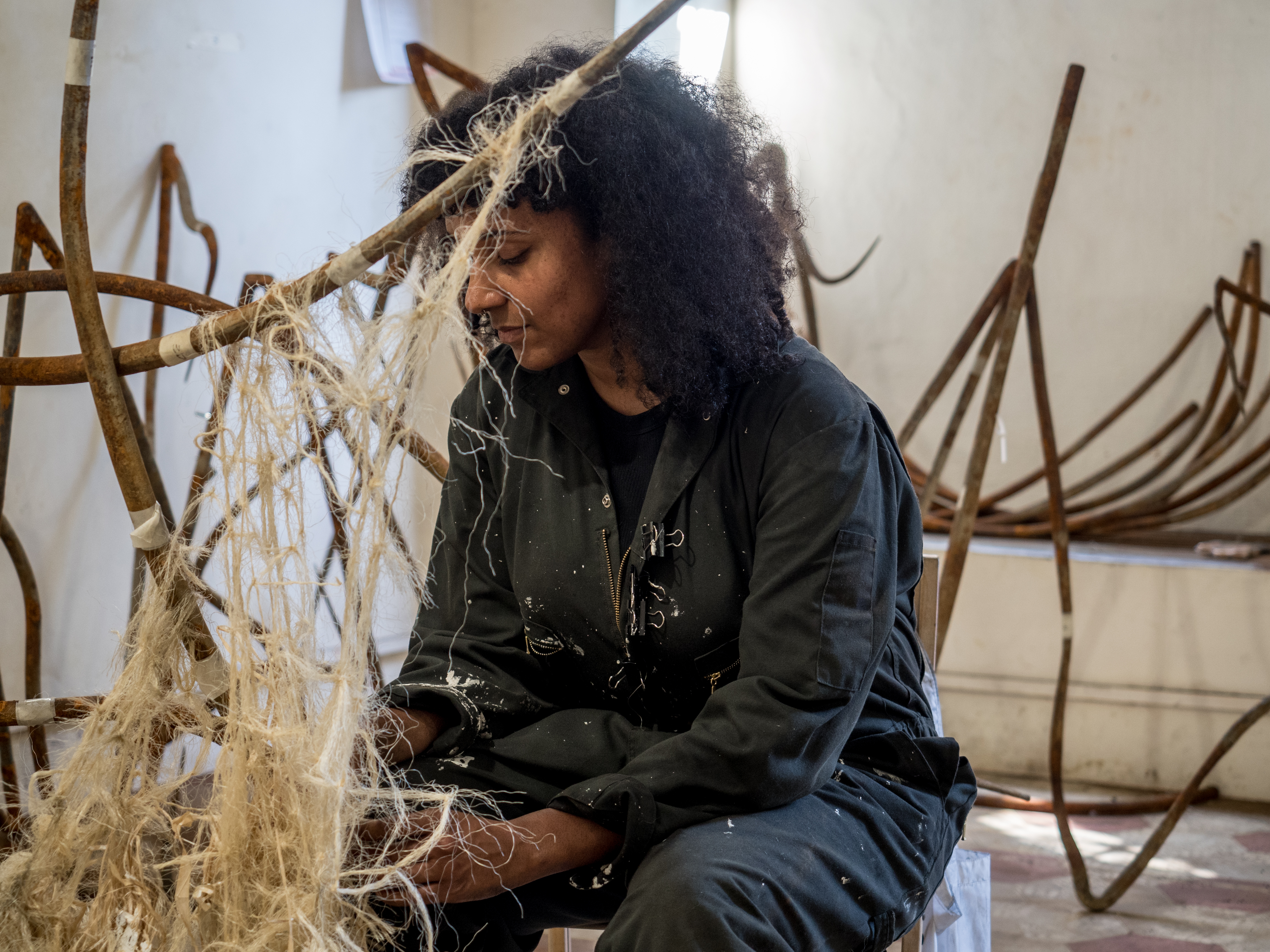
What's on? | Jul 17, 2024
Come As You Really Are

meets | Jul 15, 2024
Rituals for the Home

What's on? | Jul 11, 2024
Her Alchemy at House of Fine Art


Richard Malone: A Record of Tenderness
Last summer, Irish artist Richard Malone took over the Royal Academy’s Wohl Central Hall for this annual Summer Exhibition with a mobile installation that filled the central space. Suspended from the tall, grand ceiling and composed of intersecting metal arcs and swathes of deep blue, hand-sewn fabric, the work was an act of resistance.
In his latest exhibition, A Record of Tenderness at The Dock in Leitrim, Ireland, Malone delves into the intricate themes of labour and class, using various media to explore these deeply personal and socially relevant issues. Through his work, Malone reflects on his own experiences growing up in a working-class immigrant family in rural Ireland, a background that has profoundly shaped his approach to art and fashion. His commitment to celebrating the unseen handwork involved in traditional crafts challenges the superficiality he often perceives in the fashion industry.
Malone shares the key inspirations behind his exhibition, discussing how his upbringing and personal identity have influenced his work while examining the often invisible markers of class, the nuances of labour and skill, and the intersectional identities that form the basis of his creative expression. Through A Record of Tenderness, Malone invites us to reconsider what we value in art and fashion and to recognise the dignity and beauty in the labour that often goes unnoticed.


A Record of Tenderness explores labour and class through various media. Could you elaborate on how these themes manifest in your work and what inspired you to focus on them?
Class has always played a really important role in my work, it's based on experience and the material language of who and what I was raised around. It has also always made me feel like a complete outsider – it is a marker that is invisible and is almost never discussed which to me seems critical in the UK. The further I've moved from being a working class immigrant, which is very different from your parents moving here and being born here, to having work collected and shown in prestigious institutions at rapid succession is a bit of mind fuck. It's confusing. Often because the world I grew up in and did most of my learning in is not represented in public collections, it isn't valued.
When I make garments I'm very interested in the skill of cutting, stitching and assembly, as opposed to the industry we are in now – where people are rewarded for referencing and superficial research. I always got quite enraged watching extremely privileged people pick and choose to use the working classes as imagery, or as props. Informing silhouettes or fetishising, it's really wrong. But also it's not spoken about because very few people are working class in our industries here, and fewer are immigrants too.
My work is about celebrating the labour that goes into work, hopefully making people spend time recognising the skill involved in these ways of making which I believe are extremely beautiful. A Record of Tenderness sounds like something corporeal, but it's also about acknowledging how skills are passed from one person to the other. It looks at how we are all made of complex intersectional identities. I'm a queer, working class person from rural Ireland, with a non-specific gender, all of these things are invisible, but are real to me - it's how I exist. A.R.O.T allows this queer imagination to take centre stage and take up space in an institution with a complex history. The Dock was previously a courthouse where British forces imprisoned Irish people, often forcing them into labour camps including weaving, stitching, farming, and masonry work. The only way for me to process this, or anything really, is through making work.
I began this project with a research residency in Paris at the CCI (Centre Culturel Irlandais). I spent time studying at the restored 16th-century Irish library, as well as the Louvre and the Musee d'Orsay. I was fascinated with how society has removed queer identities of subjects, from ancient Greece and through to contemporary artists. It's really shocking that heteronormativity is so defended, when it is in fact untrue, it's a performance. It's the same with labour, stitch and the domestic, or decorating, masonry painting, signwriting are not accommodated in public collections. I think it takes someone with this identity or background to be quite shocked by this and to sincerely challenge these alleged norms. Many of the performances that appear in the exhibitions 4 films are one takes when a group of queer and non-binary performers and I discussed and reinterpreted these poses and gestures, often merging with something well represented as queer, such as Liza Minelli's knee movements in Cabaret, or Barbra Streisand's hand movements in Funny Girl. Different poses can communicate different emotions and mean very different things to different communities – but not all are immortalised in the same way, it's another hierarchy.
You use everyday materials like jersey and canvas. What do these materials represent for you?
Textiles can often be fetishised, again there is a certain hierarchy. Textile has been part of art history since the first paintings on canvas, but the weave and creation of canvas has been overlooked. These would have all been hand-woven before the automated loom, but this significant effort still goes unacknowledged. It's an age-old question about which is the art and a very conditioned value system. This is also representative in art history, for example the Renaissance, which is always lauded in art history. It was actually one of the most dangerous times to be visibly queer in history, despite some of its major artists being queer. There were more executions in Venice in this period than in any other place until Hitler's Germany. As part of my research, I looked into the labour of these people, which extended across the breadth of working-class labour: tailors, textile merchants, glassblowers, etc. There’s a very definite overlap between queerness and class and a challenge to masculinity. So what does it mean to repeat and reshare this imagery, what are we actually promoting?
I'm really interested in playing with material language, in hand stitching these sculptures together and creating pieces that sometimes suspend or move, they are sometimes just held together by this really time-consuming physical labour, and absolutely NOT a horrific AI render. At other times there are elements of patchworking, or pleating, and ironing and it's exciting for me to think about them as sort of landscapes sometimes but instead of a curated gaze, they are made out of gestures and the material or labour language of an actual place. Some of the wall-based works especially, present all of these labour practices as equal, they all participate in a kind of harmony – it's egalitarian.


You use everyday materials like jersey and canvas. What do these materials represent for you?
Textiles can often be fetishised, again there is a certain hierarchy. Textile has been part of art history since the first paintings on canvas, but the weave and creation of canvas has been overlooked. These would have all been hand-woven before the automated loom, but this significant effort still goes unacknowledged. It's an age-old question about which is the art and a very conditioned value system. This is also representative in art history, for example, the Renaissance, which is always lauded in art history. It was actually one of the most dangerous times to be visibly queer in history, despite some of its major artists being queer. There were more executions in Venice in this period than in any other place until Hitler's Germany. As part of my research, I looked into the labour of these people, which extended across the breadth of working-class labour: tailors, textile merchants, glassblowers, etc. There’s a very definite overlap between queerness and class and a challenge to masculinity. So what does it mean to repeat and reshare this imagery, what are we actually promoting?
I'm really interested in playing with material language, in hand stitching these sculptures together and creating pieces that sometimes suspend or move, they are sometimes just held together by this really time-consuming physical labour, and absolutely NOT a horrific AI render. At other times there are elements of patchworking, or pleating, and ironing and it's exciting for me to think about them as sort of landscapes sometimes but instead of a curated gaze, they are made out of gestures and the material or labour language of an actual place. Some of the wall-based works especially, present all of these labour practices as equal, they all participate in a kind of harmony – it's egalitarian.

The exhibition highlights the importance of unseen labour, with references to tradesmanship and tools like builder's chalk and masonry paint. Can you talk about how your personal background and family influence these elements of your work?
I learned labour from my family, directly. They are incredibly skilled. I worked with my dad as a painter and decorator on building sites from when I was about 13 or 14 and I learned sewing and cross stitch from my grandmother who lived next door. Even before that I would have observed and participated in making, both of those environments – the domestic with my grandmother and the industrial with my dad on housing estates – also really fascinated me with how gender is performed, and how certain labour suggests a gender and how people adjust themselves to different environments.
The materials and labour that I use allow me to question this, and hopefully make something new and sincere from my experiences and research. I have always been someone who draws, initially quite figuratively as my professor at Saint Martins is an incredible portrait artist (Howard Tangye) and observational drawing should be mandatory, but now I play more with these materials conceptually. Often overlapping or using them as an action or a gesture, or a recording of something. I like that the work actually comes from a place before my formal education, it was learned well before that. It connects to a physical place and the very real labour that constructs that world, not the gaze that people portray of romantic Ireland, which is often different from the people who live there. Studying at an art school was the thing that gave me the confidence in the world I come from, regardless of these hierarchies, it's very beautiful and complex.
Irish stitching and weaving are central to your work, but you avoid romanticising them. How do you balance honouring tradition with a contemporary approach?
I think it is always a matter of processing it in the studio, sampling, making, editing, deconstructing and reusing. I'm never using them as a tagline with the intent to sell an idea of history, I'm actually from this place and have these real experiences, I didn't discover them in a research library. I have to sit with things and processes and allow the work to happen – it takes an enormous amount of time. Not only the research but the physical labour often requires thousands of hours of work. As well as that I'll be welding and bending steel around my body before it's primed, sprayed and encased in canvas and draped or stitched. It is constructed by all these processes that are often hidden from the naked eye. It's about honouring these ways of working, respecting them, and also respecting my own imagination. It's an absolute privilege to get to spend time making this work, and it's a world away from where I started, to be truthful I never take that for granted.


How has your focus evolved over the years? What key moments have shaped your journey?
It's mostly about trust. Trusting what I have and being truthful to the source of my work. I love to study and practice and evolve, it's an endlessly fulfilling, and often very difficult endeavour. It is a very modern and capitalistic thing to do one refined thing, to deprive yourself of creativity and chaos, to develop a formula and repeat endlessly, I believe it to be a trap that adjusts how you think and feel, and I think that was my real struggle with fashion. I'm happy because I've kind of avoided any real commercial activity and made a space for myself and hopefully the place and people where I'm from. At times that is its own struggle, I don't have another person to follow who's taken a path like this, but maybe that in itself is evidence that I'm on the right one.
There have been wild things like the shows and acquisitions at the MoMA or The MET or the V&A and installing the Central Hall at the Royal Academy last year, or opening the show at the Hayward with a live, undocumented performance. They sound very impressive on paper but in reality, they are the bonuses of being very dedicated to the practice, I never really had a vision board of these things, and usually, I'm too busy to notice them happening. In reality, I'm in the studio making it all 99.9% of the time, and then I have to adjust to being social for the opening and I'm all awkward and strange and trying to refine the work. I'd say I'm most shaped by the people in my life, I've had the same group of friends for about 15 years who are also my family, as well as my family from home. It's also the people who have supported me behind the scenes, various artists and curators and sound people who've stayed by my side and helped me to make this space.